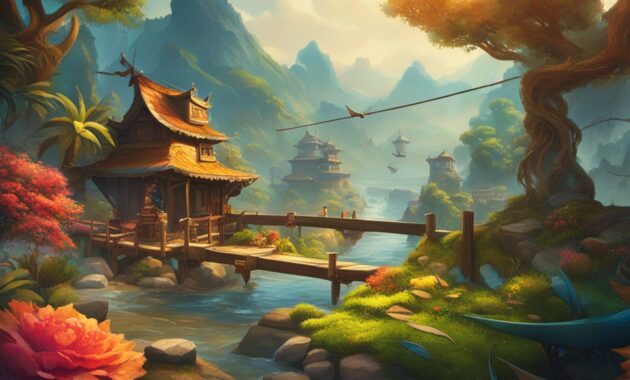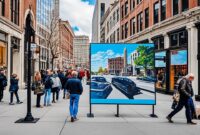Welcome to the captivating realm of digital arts, where the possibilities are as vast as the imagination. This article will guide you through the intricate world of creating and innovating with digital tools. We’ll delve into the realms of computer graphics, multimedia design, 3D modeling, animation, and interactive experiences. Prepare to explore the cutting-edge techniques and technologies that are revolutionizing visual expression. Let’s embark on a journey to unleash your creativity and immerse ourselves in the mesmerizing world of digital arts.
Key Takeaways
- Discover the limitless potential of digital arts, from computer graphics to interactive experiences.
- Explore the tools and technologies that are shaping the future of visual storytelling.
- Unlock your creative potential and learn how to bring your digital visions to life.
- Dive into the world of 3D modeling, animation, and visual effects to create captivating digital content.
- Gain insights into the thriving digital arts industry and learn how to build a career in this dynamic field.
Unleashing Your Creative Potential with Digital Arts
The realm of digital arts offers a dynamic canvas for creative minds to explore and innovate. It is a journey from conceptualization to final creation, blending human imagination with cutting-edge technology. This interplay creates a captivating exploration of artistic expression.
From Concept to Creation: The Journey of Digital Artistry
The creative process in digital arts is dynamic and rewarding. Artists start by envisioning their ideas and sketching initial concepts. They then experiment with digital tools and software to bring their visions to life. This fusion of artistic flair and technical expertise transforms the digital realm into a vibrant world of visual storytelling.
Whether crafting intricate illustrations, designing captivating user interfaces, or animating characters, digital artistry is a continuous exploration. With each digital stroke or mouse click, artists breathe life into their creations. This captivates audiences and evokes emotional responses.
Embracing Technology: Tools of the Trade
The digital arts revolution is powered by a diverse array of software and hardware. These tools empower artists to push their craft’s boundaries. From professional-grade design suites like Adobe Creative Cloud to innovative input devices, the tools continue to evolve. They offer artists unprecedented creative control and precision.
Aspiring digital artists can use these cutting-edge tools to experiment, iterate, and refine their creations. This unlocks new dimensions of artistic expression. Delving into digital arts reveals a realm of endless possibilities, limited only by imagination.
To explore digital arts further and unlock your creative potential, consider resources like Embrace the Power of Handcrafted Art, Unleashing Your Creative Skills in Art with Digital Art Classes Near, and How to Create Digital Art and Unleash Your.
“In the digital realm, the only limit is the extent of your imagination.”
The Limitless Canvas: Computer Graphics and Multimedia Design
In the digital arts domain, computer graphics and multimedia design provide an expansive canvas for creative expression. Technology’s power enables digital artists to create captivating visual experiences. These experiences convey ideas, tell stories, and engage audiences in innovative ways. The realm of computer-generated imagery has revolutionized visual communication.
Canvas X Draw stands out as a prime example of digital artistry. This software empowers artists to extend their creative boundaries. It features an intuitive Auto Trace function, precise curvature tools, and a vast template library. These tools simplify the process of converting raster images into scalable vector illustrations. Additionally, the software’s rich text tools and sophisticated color management capabilities allow artists to infuse their work with striking visual elements and nuanced details.
| Feature | Benefit |
|---|---|
| Auto Trace Function | Accurately transforms raster images into scalable vector illustrations |
| Curvature Tool | Provides precise control for creating smooth curves |
| Rich Text Tools | Allows for various combinations of color, texture, and pen strokes |
| Sophisticated Color Tools | Enables easy color mixing and precise control over hue and saturation |
| Precision Knife Tool | Segments and edits vector graphics with control over cutting paths |
The realm of digital art has expanded beyond traditional computer graphics. Artists now create interactive installations, immersive experiences, and augmented reality works. These works blur the lines between the physical and digital realms. This vibrant field has been propelled by rapid advancements in new media technologies, making it a cost-effective and versatile medium for artistic expression.
The evolution of digital art dates back to the 1950s, when computer technology was first used to create art. Over the decades, as personal computers became more accessible, digital art gained mainstream recognition. Pioneers like Andy Warhol showcased the medium’s potential. Today, the rise of NFT (Non-Fungible Token) art has further propelled digital art into the spotlight, offering artists new avenues to showcase and monetize their creations.
“Digital art has expanded the boundaries of what is possible, allowing artists to create interactive installations, immersive experiences, and augmented reality works.”
The digital arts continue to evolve, showcasing the synergy between computer graphics, multimedia design, and cutting-edge technologies. Digital artists and graphic designers collaborate seamlessly, utilizing a wide range of software tools to bring their visions to life. From the masterful use of Adobe Photoshop and Illustrator to the immersive capabilities of 3D modeling programs like Blender and Autodesk Maya, the digital arts landscape reflects the limitless potential of human creativity and technological innovation.
Bringing Imagination to Life: 3D Modeling and Animation
In the realm of digital arts, 3D modeling and animation stand as pivotal elements for crafting virtual worlds and compelling narratives. Through the detailed process of 3D modeling, artists sculpt and shape the essence of these digital realms. They infuse life into characters, objects, and environments, transforming abstract concepts into tangible realities.
Sculpting Virtual Worlds: The Art of 3D Modeling
The realm of 3D modeling is a complex journey, where artists employ specialized software to convert conceptual designs into three-dimensional entities. This process, from initial sketch to the final model, requires a harmonious blend of technical proficiency and creative insight. Utilizing advanced tools and methodologies, these digital craftsmen meticulously sculpt and refine virtual forms, textures, and surfaces. This meticulous process brings their imaginative visions to tangible existence.
Animating Captivating Stories: The Magic of Animation
Following the meticulous creation of virtual worlds and characters through 3D modeling, animation becomes the next step in their animation. Animators, with their acute sense of movement and timing, infuse life into these digital entities. They harmonize their motions and expressions to narrate captivating stories. The art of animation elevates the static 3D models into dynamic, living beings that captivate audiences and immerse them in the digital realms.
| 3D Modeling Techniques | Animation Principles |
|---|---|
|
|
The synergy of 3D modeling and animation has heralded a new epoch in digital storytelling. This fusion empowers creators to actualize their most imaginative conceptions, transporting audiences into immersive virtual realms. By excelling in these digital art forms, artists unlock the vast potential to forge unforgettable experiences. They leave a lasting impact on the digital arts landscape.
The Future of Visual Storytelling: Digital Arts
The realm of digital arts is undergoing a significant transformation, redefining the future of visual storytelling. Technological advancements are opening up new avenues for creating immersive and visually striking experiences. At the core of this transformation are visual effects and motion graphics. These tools are revolutionizing how we perceive and engage with our surroundings.
Enhancing Reality: Visual Effects and Motion Graphics
Visual effects and motion graphics have become indispensable in the digital arts, seamlessly merging reality with the fantastical. By leveraging augmented reality and virtual reality technologies, artists and designers can transport viewers into new dimensions. This blurs the distinction between the physical and the imaginary.
The reach of visual effects goes beyond entertainment, penetrating sectors like education, healthcare, and marketing. These industries utilize these innovative methods to craft compelling visual stories. From lifelike 3D simulations to dynamic animations, the impact of visual storytelling is profound. It educates, informs, and inspires audiences in ways previously unimaginable.
| Technique | Application | Impact |
|---|---|---|
| Visual Effects | Film, Television, Gaming | Heighten realism and immersion |
| Motion Graphics | Branding, Advertising, Explainer Videos | Engage audiences and convey complex information |
| Augmented Reality | Education, Retail, Healthcare | Blend digital and physical experiences |
| Virtual Reality | Gaming, Simulations, Therapy | Create fully immersive environments |
The future of visual storytelling in digital arts is vast and full of potential. By leveraging visual effects and motion graphics, creators are developing experiences that captivate, educate, and inspire like never before. This marks a new era in storytelling, where the boundaries between imagination and reality are continuously pushed.
Crafting Immersive Experiences: User Interface Design
In the realm of digital arts, the seamless integration of user interface (UI) design is paramount. UI design is essential for creating immersive experiences that engage users deeply and facilitate effortless navigation through digital products and services. This integration is vital for enhancing the overall user experience.
UI designers and digital artists work in tandem to forge interfaces that are both visually striking and user-centric. Their combined expertise in user experience, interactive design, and digital art transforms the digital environment into a captivating space where aesthetics and functionality are in perfect harmony.
The discipline of user interface design demands a deep understanding of user needs, behaviors, and preferences. Designers meticulously plan every detail, from the layout and typography to the color schemes and interactive elements. This meticulous approach ensures a smooth and engaging user journey.
“The best interfaces are invisible, allowing users to focus on the task at hand rather than the technology itself.” – Jakob Nielsen, User Experience Specialist
Effective UI design not only elevates the visual appeal of digital products but also equips users with the tools to navigate and interact with them proficiently. By adhering to user-centered design principles, designers craft interfaces that are not only responsive and accessible but also adaptable to the diverse needs of users.
The collaboration between digital artists and UI designers transforms the digital landscape into a canvas for immersive experiences. This synergy results in the creation of intuitive mobile apps and captivating web interfaces. The blend of creativity and technical acumen enables users to explore, discover, and engage with digital content in a profound and engaging manner.
The Art of Interactive Engagement: Game Design

In the digital arts, game design stands out as a complex discipline. It combines creativity with coding to create engaging interactive experiences. Game designers, with their artistic vision and technical skills, invite players into immersive digital worlds.
Blending Creativity and Coding: The Game Designer’s Role
The role of a game designer is a balance between artistic expression and technical implementation. They have a unique set of skills, merging game design, interactive art, interactive design, coding, and creativity. They develop the game’s story, characters, and settings, while also handling programming and game engines.
Game designers go beyond just coding; they are storytellers, artists, and strategists. They design the player’s journey, making sure each interaction is engaging and visually appealing. By understanding human behavior and psychology, they create game mechanics that enhance immersion, challenge, and player satisfaction.
The art of game design is more than just technical skills; it’s about balancing aesthetics, gameplay, and user experience. Game designers need to know about visual and sound design, as well as interactive principles, to create a cohesive and immersive experience.
“Game design is the art of applying design and aesthetics to create a game for entertainment or for educational, exercise, or experimental purposes.”
Through their expertise in game design, these professionals are pushing the limits of interactive art. They create digital experiences that captivate, inspire, and challenge players. By combining their creative vision with technical skills, game designers are shaping the future of interactive engagement. They’re redefining how we experience and interact with digital worlds.
| Key Aspects of Game Design | Description |
|---|---|
| Gameplay Mechanics | The fundamental rules, actions, and interactions that define the core gameplay experience. |
| Narrative and Storytelling | The crafting of compelling narratives, characters, and environments that engage players emotionally. |
| User Experience Design | The optimization of the player’s journey, ensuring intuitive controls, responsive feedback, and seamless interactions. |
| Visual and Audio Design | The creation of visually striking and aurally captivating game environments, characters, and effects. |
| Game Balancing and Testing | The iterative process of adjusting game mechanics, difficulty, and pacing to ensure a well-balanced and engaging experience. |
Pushing Boundaries: Exploring Interactive and Experimental Digital Arts
Embark on a journey into the realm of interactive and experimental digital arts, where visionary artists redefine the limits of creativity. Dive into the forefront of new media art, pioneering digital installations, and avant-garde expressions. These artists challenge traditional art forms and revolutionize our digital interactions.
This journey reveals the immense creativity at the nexus of technology and art. Discover how digital installations merge the physical and digital, and how experimental digital art redefines storytelling. These innovators are setting new standards for artistic expression.
At the vanguard of this movement, interactive art engages the audience, transforming passive viewing into an active experience. These digital installations utilize technology to craft artworks that are captivating, responsive, and dynamic, offering an immersive encounter.
Delve into the realm of new media art to explore the vast potential of digital tools and platforms. From virtual and augmented reality to generative art and interactive narratives, these avant-garde expressions blend technology, interactivity, and conceptual depth. They create experiences that transcend traditional art forms.
Join us in exploring the expansive world of interactive and experimental digital arts. Here, creativity and technology converge, sparking a revolution in artistic expression. Be prepared to be captivated, challenged, and inspired by the visionary artists redefining art’s future.
“Art is not a mirror held up to reality, but a hammer with which to shape it.” – Bertolt Brecht
Building a Career in the Digital Arts Industry
The digital arts industry is a thriving and dynamic field, offering a diverse range of career opportunities for creative individuals. From cutting-edge digital arts careers in computer graphics and multimedia design to the captivating world of game development and interactive experiences, this industry is constantly evolving. It is driven by technological advancements and the ever-growing demand for innovative digital content.
As you embark on your journey in the digital arts industry, it’s crucial to stay informed about the latest industry trends and develop a comprehensive understanding of the various career paths available. Whether you aspire to become a 3D modeler, a visual effects artist, or a user interface designer, the key to success lies in your ability to continuously learn, adapt, and hone your skills.
Networking and Collaborating in the Digital Arts Community
One of the most valuable assets in the digital arts career realm is the power of networking and collaboration. By connecting with fellow artists, industry professionals, and like-minded individuals, you can unlock a world of opportunities, gain valuable insights, and foster meaningful relationships that can propel your career forward.
- Attend industry events, conferences, and meetups to connect with other digital arts enthusiasts and professionals.
- Engage with online communities, forums, and social media platforms dedicated to the digital arts industry.
- Collaborate on projects with other creatives, leveraging each other’s unique skills and perspectives to produce exceptional digital content.
- Seek out mentorship opportunities to learn from experienced digital arts practitioners and gain valuable insights into the industry.
By actively networking and collaborating within the digital arts community, you can not only build a strong professional network but also stay inspired, motivated, and at the forefront of the latest industry trends.
| Networking Strategies | Collaborative Opportunities |
|---|---|
|
|
By embracing the power of networking and collaboration, you can unlock new doors, expand your skillset, and position yourself for long-term success in the thriving digital arts industry.
Staying Inspired: Resources and Communities for Digital Artists
For digital artists, the pursuit of inspiration and skill enhancement is paramount to creative flourishing. A plethora of resources and dynamic online communities stand ready to support and empower artists. Educational platforms provide digital art tutorials, while professional organizations facilitate collaboration, offering ample opportunities for knowledge expansion and connection with peers.
Delve into a plethora of online tutorials, webinars, and workshops tailored for both novices and experts in digital art. Platforms such as Skillshare, Udemy, and LinkedIn Learning present a broad spectrum of courses, covering digital painting, 3D modeling, animation, and beyond. Engage with these resources to hone your skills and venture into new artistic territories.
Connect with digital art communities on social media platforms like Behance, Instagram, and DeviantArt. These vibrant forums enable you to exhibit your creations, solicit feedback, and interact with a worldwide community of creatives. Engage in online challenges, join specific groups, and tap into the collective knowledge of the community to maintain inspiration and drive on your artistic path.





